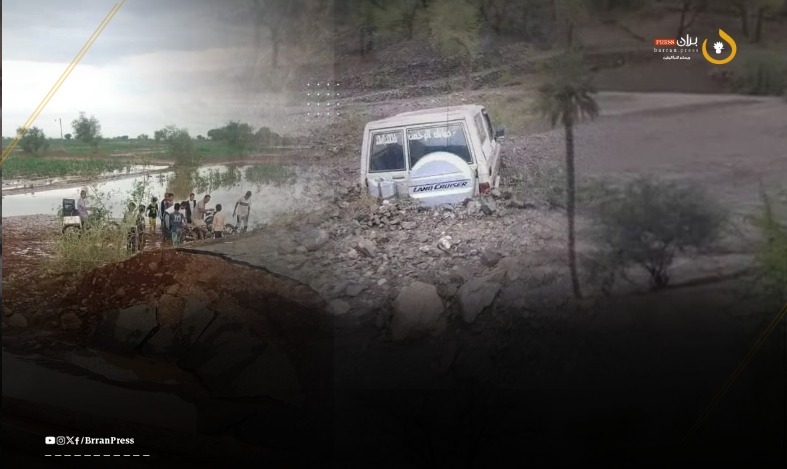


Barran Press
Torrential rains that turned into a low-pressure system on Thursday, August 1, 2024, caused significant damage and material losses in Maqbana district, west of Taiz governorate in southwestern Yemen.
According to statistics obtained by Barran Press, flash floods in the "Wadi Hajar" valley in the "Shamir" region of Maqbana district resulted in the collapse of the "Hijjat al-Awja" mosque, the destruction of 13 homes, the washing away of a cemetery, the burying of four water wells, and the uprooting of 350 palm and mango trees.
The devastating floods that swept through the valleys of "Hajar, Dhanb, Nashma, and Bidha" in Shamir Maqbana led to the disappearance of five people, the destruction of a commercial store and a saloon car belonging to Mubarak Mansour, the demolition of a brick and tile factory and a car belonging to Nabil Saif, the burying of a water well, the destruction of the drinking water project for the village of Kadama, the Hijjat al-Awja mosque, a commercial store belonging to Rashad Jamal, and another commercial store belonging to Mohammed al-Hajj.
The floods also destroyed another well and the water project system in the villages of "al-Ghabari," as well as a well and orchard belonging to Ghaleb al-Hajj and his brother Mohammed al-Hajj. Approximately 350 palm and mango trees were uprooted, and 13 homes and a cemetery were damaged in the same villages. Furthermore, vast areas of land and numerous wells in the Wadi Nashma were affected.
Barran Press obtained a detailed report on the human and material losses caused by the heavy rains in the districts and villages of Maqbana, encompassing homes, farms, wells, mosques, houses, and commercial stores.
The villages affected by the floods in the Bidha region are: al-Majgabib, al-Manabira, al-Kadaf, al-Ghabari, Bidha, al-Awja, Kadama, al-Gail, al-Habis, Qoufa, and Sha'b al-Jabala.
The floods in these villages resulted in the washing away of four cars, seven water pumps, two water systems, two cattle, 11 wells, three mosques, seven houses, six shops, two missing individuals, and five water tanks. The damage in the higher-altitude region of Akhdou'a, encompassing the villages of al-Raha, al-Jararib, Qabaa, al-Hajar, and Sa'anb, included 11 farms, wells, and water pumps.
The damage in the Bani Saif region, specifically the al-Barh area, included two houses, while a single car was damaged in the village of al-Sawag in the Wagin region.
Community activist Najeb al-Shamri, who compiled the statistics on the losses, spoke to Barran Press about the "severe" damage inflicted on infrastructure and property in the area as a result of the recent low-pressure system.
Al-Shamri stated that the floods completely buried 11 wells, with only one well remaining unaffected due to its concrete enclosure. He emphasized that mosques also suffered damage, with one mosque completely destroyed and two others partially damaged, particularly in the minaret and surrounding areas.
Regarding the impact on local communities, he explained that community-based water systems that pumped water to tanks in neighboring villages were completely destroyed by the floodwaters. He pointed out that houses sustained significant damage, with the damage approaching the foundations, posing a risk of collapse at any moment, especially in the event of further flooding or an earthquake.
The activist added that the tanks that collected water from the wells, used for supplying homes and livestock with water, were severely damaged.
The damage extended beyond property to agricultural land, with al-Shamri confirming that it was "completely destroyed," exacerbating the suffering of residents in the area.
Al-Shamri urged the relevant authorities to "take swift action to address this damage and provide necessary support to the affected individuals."
In a similar vein, the official Yemeni news agency Saba reported that a committee headed by the Deputy Governor for Coastal Affairs, Engineer Rashad al-Akhlali, inspected the "flood damage in Maqbana district, assessing and documenting the damage caused by the floods, understanding the concerns of the citizens, and witnessing their suffering."
The agency quoted Deputy Governor al-Akhlali as saying that the assigned committee had "commenced its field visit with engineers to the Suwaihra area in the Braisha region, the area most severely affected by the floods, which resulted in the washing away of agricultural land and irrigation channels leading to it, the burying of two water wells, and damage to several homes, secondary and main roads due to the floodwaters."
He added that the committee had "documented and assessed the damage," noting that "a detailed report on this damage and the necessary remedies will be submitted to the leadership of the local authority for taking the necessary measures."
Deputy Governor al-Akhlali, according to Saba, called on "organizations and bodies to assist the affected areas within Maqbana district."
Earlier, the National Center for Meteorology and Early Warning had reported that most Yemeni governorates would experience heavy thundershowers and varying levels of rainfall over the next 42 hours, urging caution and avoiding low-lying areas and flood channels.
Since the end of last month, most Yemeni governorates have experienced heavy rains, particularly the northwestern highlands, which have been transformed into a low-pressure system that has caused casualties and property damage.
Yemen suffers from severe infrastructure weaknesses, making the impact of floods even more devastating for residents who are already struggling with the deterioration of basic services due to the ongoing war for nine years.